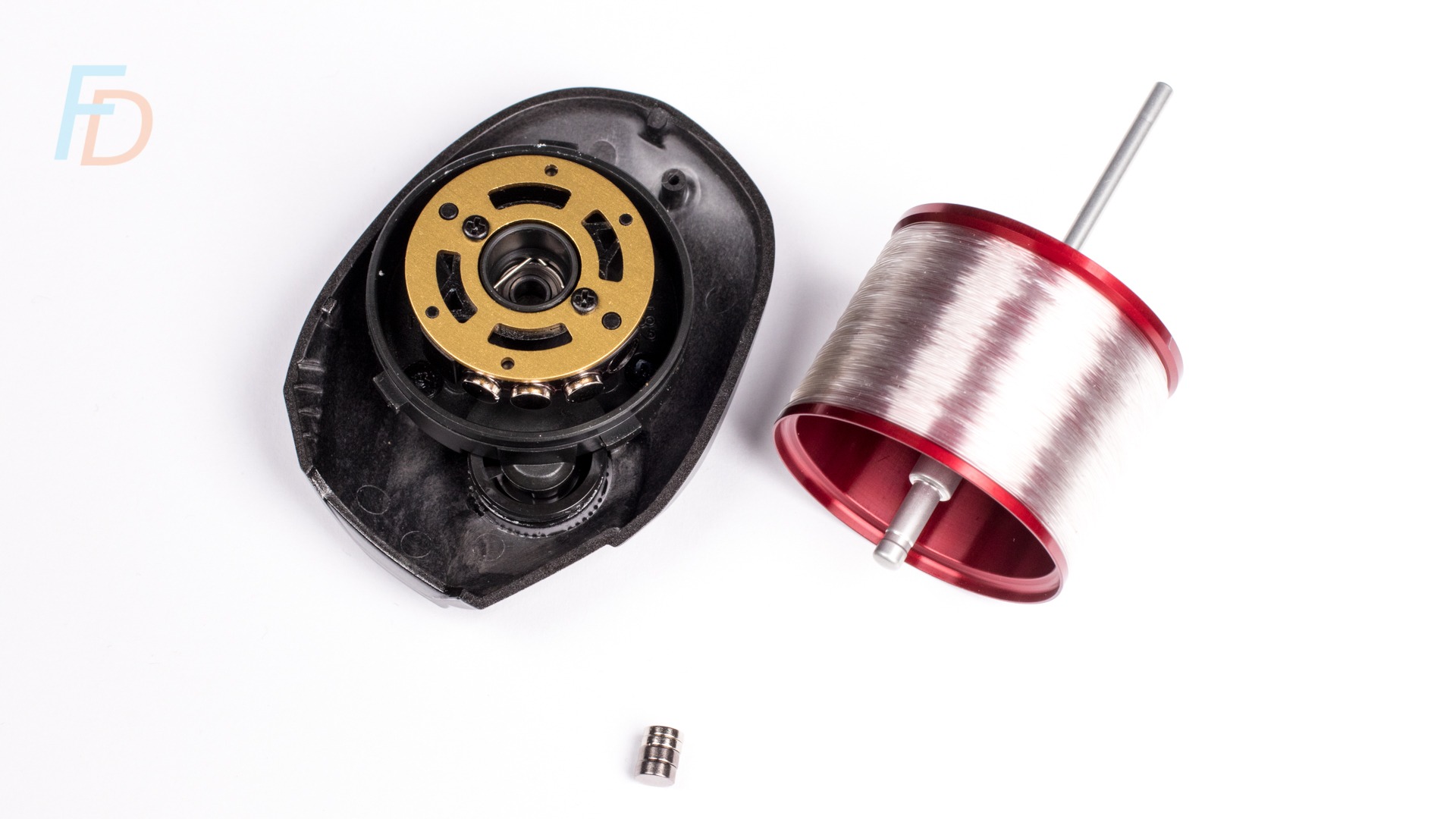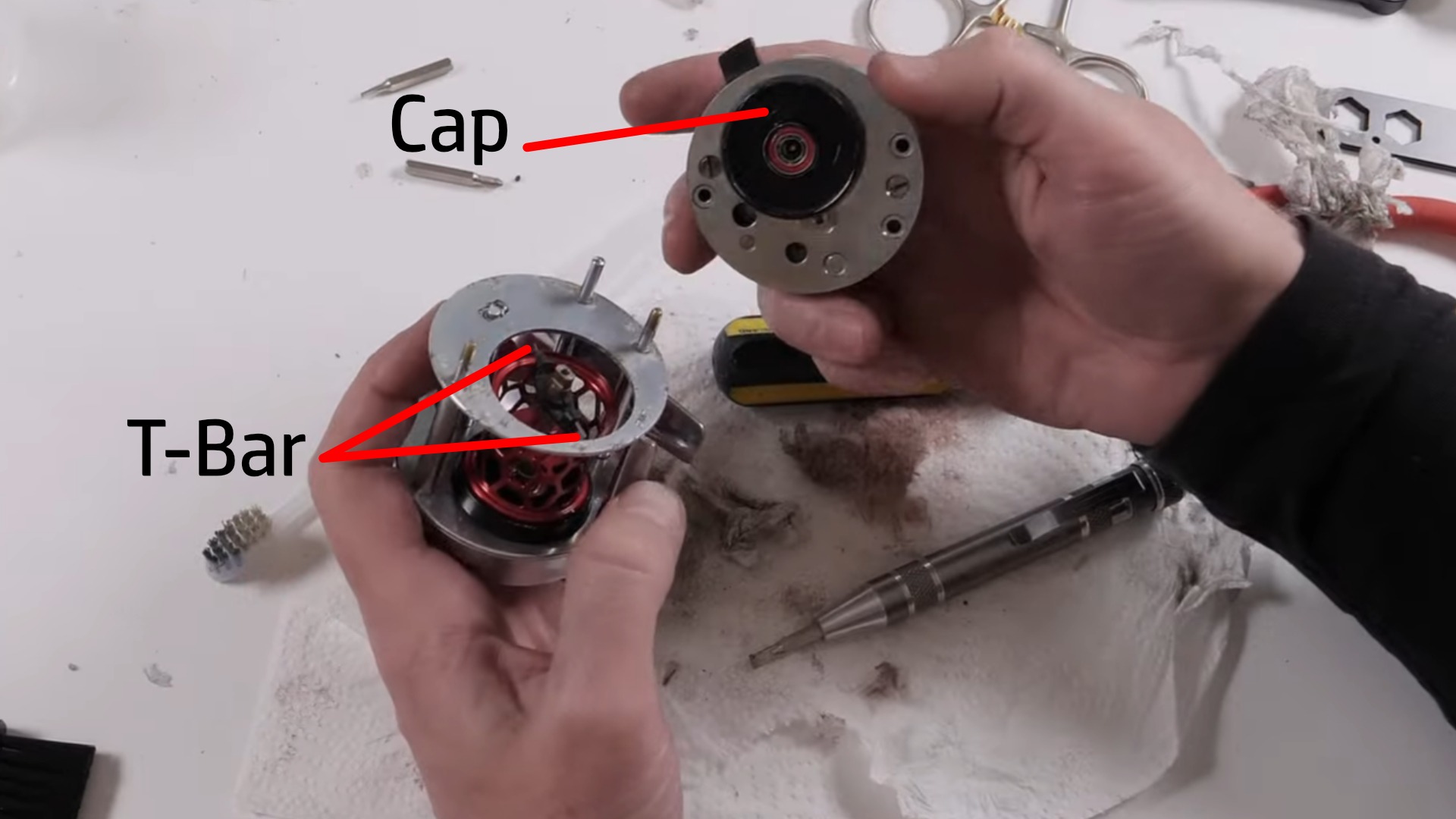Choosing the best baitcaster braking system probably gets more difficult the lighter the lures you intend to throw. Here's a quick reference guide to making a good choice.

Note: Product links to Aliexpress in this article will generate commission on qualifying purchases - even on the special 11.11 sale price items which save you money (and affiliate links do not alter the sticker price you pay).
Sometimes the Best Baitcaster Braking System is Your Thumb
It can be pretty annoying when casting gurus are a bit too keen to tell you all about their "educated thumb". When all is said and done, it is true that developing a good sense of how and when to thumb the spool can only improve your casting ability.
However, it is also worth knowing that below a certain lure weight - say under 1.7g (~1/16th oz) - throwing for maximum range will be all but impossible if you're relying only on your thumb. Controlling those rpms as the spool starts up in response to a strong cast - while also allowing the ultralight lure to fly out freely - requires a responsiveness that mere mortals don't posses.

Whenever I'm using my grandfather's Pflueger Summit baitcaster (above), there is no choice but to use only thumb control - since the super-basic backlash control mechanism broke many decades ago. I've found with the metal "Acehi" Pflueger rod I can roll cast lures down to about 9 or 10 g.
Generally speaking though, the heavier the lure and stronger the rod, the easier you'll find it to control the spool with no brakes and just using thumb pressure. If the inner rim of the spool is exposed, that provides the smoothest surface and some experts prefer to thumb that rather than the line wrapped around the main body of the spool.
Brakes on Bait Finesse System Reels: How FTB Brakes Work
Let's go to the complete opposite end of the spectrum from weighty lures and strong rods. In the ultra finesse baitcasting world of BFS, avoiding weight in the spool and also gaining highly sensitive control of the spool is of maximum importance.
Pushing the limits of this style you can lures that might be only weigh 1 g or less. It is even possible to fish with bead-head nymphs used in fly fishing down to just under 0.5g (around 1/60th of an oz) with the most refined bait finesse tackle. However, generating the rod-tip speed needed to throw such a light bait means that the brakes must be highly responsive in order to control the spool - and yet not hold back the lure once it is in flight.
At first sight the best baitcaster braking system for ultralight lures would seem to be a computerised brake system (see the DC brake section below); however BFS is all about lightweight and highly compact gear. It could be difficult to create a computerised braking system that is small and lightweight enough to be compatible with Bait Finesse System reels.
Instead, one of the most significant developments so far was when Shimano introduced their Finesse Tuned Brake (FTB) system. The huge innovation was to achieve dynamically-varied braking without adding any extra weight or material to the spool.

This means that stronger braking is applied when it is needed at the spool start-up and rapid acceleration phase at the beginning of the cast. Then, as the lure is in flight - braking control is backed off by a combination of reduced magnetic force AND the movement of the magnets away from the spool. This allows the maximum distance of very light lures to be squeezed out of the latter stages of a cast.
The brilliant mechanism by which these brakes work is often misunderstood - as people who copied this solution found out when using exactly the same brake configuration for left hand reels as for the original right-hand reels. Because Shimano designed the mechanism, they knew that you need to create mirror-image brake systems for left versus right hand reels!
Here's why:
It is clear that Shimano executed their left and right hand reels brilliantly - and you can examples of this in the Fishing Discoveries articles dedicated to:
Encompassing mid-price to premium-priced reels - these are often what anglers "graduate" to once they have fallen in love with BFS. However, that gateway purchase for people trying it for the first time is often done with a much more restricted budget.
That is why having high-performance budget reels is also essential to bring in newcomers - and why both ends of the market actually need each other!
So - even given the static version of the FTB brake; the superlight stock spools and the rest of the reel design means you can achieve phenomenal casting with a lure as light as 1 g (1/28th oz) with bargain reels covered in Fishing Discoveries articles (linked in orange) such as the:
- Dark Wolf Ultra (5.3-g spool comes alive with Roro bearings: best performance for reel-tweakers)
- Black Knight II (5.7g spool - but with ABEC 7 ceramic bearings as stock: best performance for hands off/out of the box fans)
NOTE: The new, "Static FTB" brakes no longer require additional magnet upgrades.
Compacting the Static Magnetic Brake (MagTrax Style)
Now, to recap the current evolution of affordable-construction/high casting performance budget reels - which began by adopting dynamic FTB style brakes and then locked those spring-loaded brake shoes in place (taking out the springs in the process). We now have a new crop of super-compact reels with ultralight stock spools with static braking systems based on a similar platform to the Abu Garcia MagTrax magnetic brakes - which had already been adopted by reels such as the Fishband Hyper Micro eg. below:

Although not identical, the basic arrangement of magnets and spool "inductor plate" is very similar to the original MagTrax system
The latest current crop of such reels have incredibly light stock spools and two interesting choices you can check out via my affiliate links below include the Soloking Acura (which has options for different gear rations and also an option to include a slightly deeper spare spool along with the BFS spool) and also the Tsurinoya Genius - these look set to take over where the DWU and BKII blazed a trail:
Soloking Acura
Tsurinoya Elf (lower gear) Genius (higher gear)
With the side-plate static (though still adjustable) MagTrax style and the true, dynamic, FTB-style described; that explains the main uses of multiple "bead" style magnets. For Daiwa's innovative approach to both dynamic and static magnetic brakes (including for BFS reels) let's jump into the next section...
Daiwa MagForce brakes (including "SV" and "Air")
All of daiwa's current magnetic braking systems would fall under the umbrella design of their MagForce system. While you will see different names for this across different models - for instance their BFS brakes are referred to as "Air" brakes - the differences are based in the strengh of the springs used and the dimensions of the inductor cup.
In this system, the spools are manufactured with an extra, cup-shaped inductor at one end. This cup is attached to a rotor on the spool spindle and the cup is held in a retracted position by means of a spring. When spool rotation exceeds a certain speed, the rotor pushes outwards against the spring and extends the cup into the gap between concentric ring-shaped magnets in the sideplate of the reel.
On the Alphas Air TW 20, it looks like this:

The "SV" (Stress-free Versatile) brakes work on the exact same principle and can be found reels such as:
...and many more
STATIC Daiwa Magforce Brakes?
Interestingly, for some BFS applications, there are deliberate moves to a static version of this system. This is simply achieved by locking the inductor in place - and you can see how and why this is done in articles on:
- Daiwa Alphas Air Stream Custom (quick-fire/ultimate short-range accuracy trout stream fishing reel)
- Roro's AX22 range of unbelievably light spools (the rotor and spring would add significant mass to the 3.68-g lightest model!)
A recent adopter of the static Air brake is the lovely Silver Creek model (an update on the Air Stream Custom).
Daiwa Air TW Stream Custom Silver Creek 22
Best Baitcaster Braking System: Centrifugal Brakes
Probably my favourite example of this style of brake is the wonderfully elegant, simple and effective braking found in the old Abu Ambassadeur 2500C and 1500C and related reels. The simple Ambassadeur mechanism has a kind of "T" bar sticking out from the spool spindle.
On either one (for low braking) or both (more braking) halves of the cross-bar of the "T" there is a tiny cylindrical block mounted. In the sideplate is a cap which, when the reel is put together, fits around the ends of the "T". If the spool spins fast enough, the brake block(s) fly out towards the end of the cross-bar and rub up against the inside of the cap.

With an ultralight, modern spool this mechanism even works incredibly well for BFS (e.g. below ultralight lure tuned 1977 Ambassadeur). However, the limitation is that the spool weight needs to incorporate the mass of the T-bar and brake blocks as part of its rotational mass - causing more inertia compared to the passive-induction of magnets on the FTB system or the inclusion of a relatively light aluminium inductor plate or cup.
There are quite a few variations on centrifugal brakes - some including springs so that zero braking is applied until a certain, higher rotational speed is reached (or after the spool drops back down to low speed). However, they all rely on the physical abrasion of brake blocks against a rotating surface - along with those blocks being flung outwards by centrifugal force.
There are even combined magnetic and centrifugal brakes (e.g. the Abu Garcia Revo SX and their infini braking system) - however, users seem to feel that it would be better to pick one style of brake and refine that rather than try to cover more bases with a mixture of mechanisms.
Overall, this style could be the best baitcaster braking system for any fishing situation that needs the braking to drop to absolutely zero at certain, low-speed, points during the cast. Bear in mind that magnetic brakes (even dynamic ones) tend to exert some braking force when the spool is in motion (since the magnetic force is never entirely shut down). The main drawbacks of centrifugal brakes include rotational mass (and hence inertia) that they add to ultralight spools. There is also the physical wear and tear over time caused by building a friction-based braking system (compared to magnetic induction).
Digital Chip (DC) Baitcasting Reels: Best Baitcaster Braking System for Trouble-Free Fishing
These are closely-guarded industrial secrets - and are probably the best baitcaster braking systems for almost guaranteeing you avoid backlashes! The basic concept is that a sensor scans the rotation of the spool many times per second and that information is sent to a small computer chip which calculates how to apply the brakes in order to control the spool. The application of the brakes is done a little like Advaned Braking System (ABS) braking in cars - where the brakes are applied and then removed in rapid succession.
This gives DC reels a very characteristic sci-fi style electronic whine or groaning sound during the cast. While, in theory, these reels should cast the furthest of all options - especially into a headwind - it can be the case that the electronics play things a bit safe and choke down some of the distance in particular conditions of wind compared to more traditional baitcaster braking systems.
Overall, DC systems probably offer the best baitcaster braking system for avoiding backlashes and trouble-free fishing with baits above the finesse weight class. Bombing out reaction baits should be their sweet spot role!
With all that technology, you'd expect DC reels to only be available to those with a big budget - however they actually span the full range from around $150-$200 USD up to over $600...
For instance:
Shimano SLX DC
Or - for a full-on luxury option
Shimano Antares DC
Best Baitcaster Braking System Round Up
As a short summing up, the best baitcaster braking system (as always) will vary from person to person and between different fishing applications. The following broad guidelines may help narrow down your choices:
- Styles needing braking at highest speeds - but also benefit from zero brakes at low speed (e.g. pitching): Spring-loaded centrifugal braking
- Ultralight lures with maximum distance: Dynamic Magnetic brakes (FTB or Air)
- Ultralight lures with maximum accuracy and short, fast, low casting: Static Magnetic brakes
- Long range bombing with some thumb control in headwinds for max distance: Either Static Magnetic or Centrifugal
- Trouble free bombing with maximum insurance against backlashes: DC
Enjoy your fishing!
Paul





